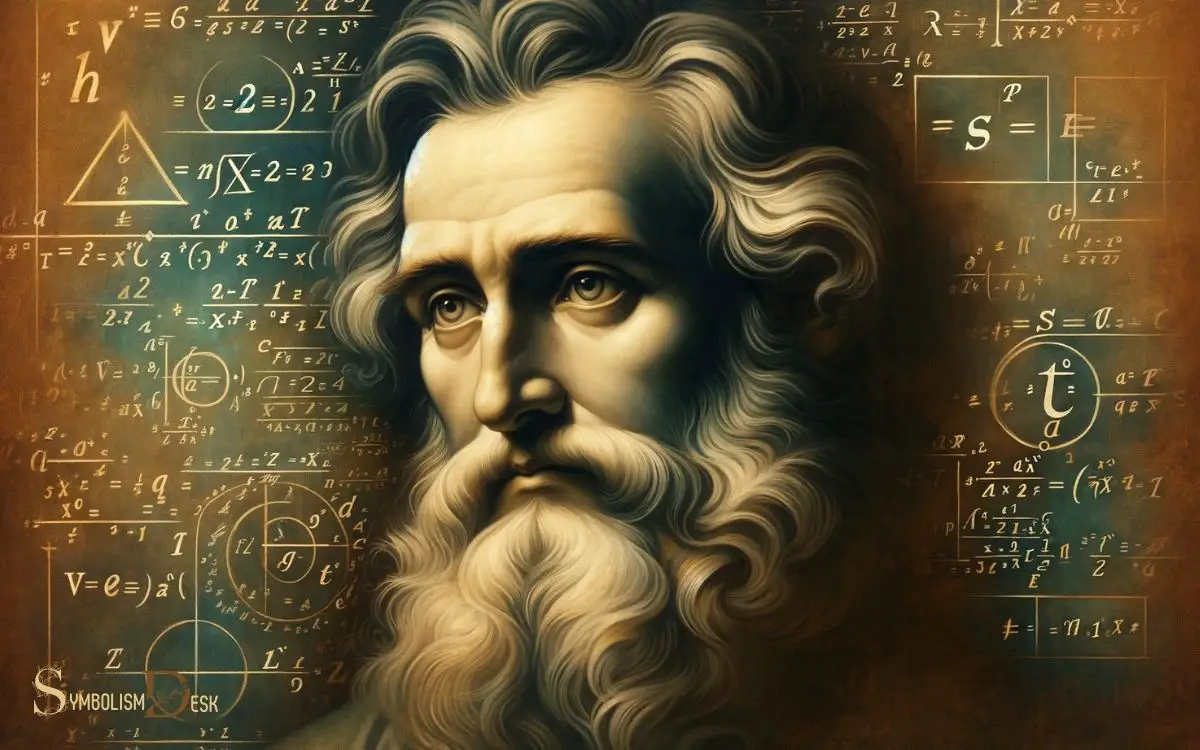Introducer of the Math Symbol E: Explain!
The mathematical constant ‘e’ was first introduced by the Swiss mathematician Leonhard Euler in 1727. Recognized for its natural occurrence in various mathematical and physical contexts, ‘e’ is approximately equal to 2.71828 and is the base of the natural logarithm.
The symbol ‘e’ stands for the base of the natural logarithm, which is an irrational and transcendental number. It is known as Euler’s number after Leonhard Euler who popularized its use.
The importance of ‘e’ arises from its unique properties in calculus, particularly in the context of exponential growth and decay, compound interest, and in describing certain complex oscillations.
For example:
- The function e^x is its own derivative and integral.
- In finance, ‘e’ is used to calculate continuous compounding interest.
Euler’s number ‘e’ is a cornerstone of mathematical constants, integral to the fields of calculus, complex analysis, and number theory.

Key Takeaway
Introduction and History of the Mathematical Constant ‘e’
| Year | Event |
|---|---|
| 1618 | John Napier introduces logarithms, setting the stage for later concepts of natural logarithms. |
| 1683 | Jacob Bernoulli discovers the constant when studying compound interest. |
| 1727 | Leonhard Euler introduces the symbol ‘e’ and helps to establish its importance in mathematics. |
| 1748 | Euler publishes “Introductio in analysin infinitorum” where he discusses the properties of ‘e’. |
Early Origins of the Symbol ’e
Although the early origins of the symbol ‘e’ are not definitively known, its usage can be traced back to the 17th century. The symbol ‘e’ is commonly used in mathematics and represents the base of the natural logarithm.
Its introduction is often attributed to the Swiss mathematician Leonhard Euler, who utilized it in his work on calculus and number theory. However, there is evidence to suggest that the symbol had been in use prior to Euler’s contributions.
Some sources indicate that the symbol ‘e’ may have originated from the first letter of the word “exponential” or “exponentialis” in Latin, as exponential growth and decay were integral concepts in early mathematical studies.
Regardless of its precise origin, the symbol ‘e’ has become a fundamental component in mathematical notation and continues to play a crucial role in various mathematical disciplines.
The Emergence of the Natural Logarithm
The emergence of the natural logarithm, often denoted as ln, marks a significant development in the history of mathematics.
Originating from the need to solve exponential growth and decay problems, the ln function has found wide-ranging applications in calculus, particularly in the evaluation of integrals and derivatives.
Understanding the origins and applications of the ln function provides valuable insight into the development of mathematical concepts and their practical utility in various scientific and engineering disciplines.
Origins of Ln Function
The emergence of the natural logarithm, or ln function, can be traced back to the development of logarithms in the 17th century. Initially introduced by John Napier and later refined by Henry Briggs, logarithms provided a means to simplify complex mathematical calculations.
The ln function specifically arose as a natural extension of the concept of logarithms, offering a base for exponential functions that is fundamental in calculus and various scientific disciplines.
The historical origins of the ln function evoke a sense of fascination, as it represents a pivotal advancement in mathematical theory and practical computation.
The cultural impact and intellectual significance of this development continue to resonate with mathematicians and scholars, underscoring its enduring relevance in modern mathematics.
Applications in Calculus
When considering the emergence of the natural logarithm in calculus, it becomes evident that its applications play a significant role in modeling natural phenomena and solving differential equations.
The natural logarithm, often denoted as ln, is closely tied to exponential growth and decay, making it a fundamental tool in calculus.
In the realm of differential equations, the natural logarithm naturally arises when dealing with rates of change that are proportional to the current value, such as in radioactive decay or population growth.
Moreover, in calculus, the natural logarithm is intricately linked to the concept of integration and is essential in solving a wide array of mathematical problems.
Understanding the applications of the natural logarithm is crucial for comprehending the profound impact it has had on the development of calculus.
The Pioneering Mathematician and Their Influence
One pioneering mathematician who significantly influenced the introduction of the math symbol E was Leonhard Euler.
Euler, a Swiss mathematician, made significant contributions to the field of mathematics, including the development of the mathematical notation for the exponential function.
His work laid the foundation for the use of the symbol “E” to represent the base of the natural logarithm and the transcendental number approximately equal to 2.71828.
Euler’s influence extended beyond his notation contributions, as he played a crucial role in shaping modern calculus and analysis.
His innovative thinking and groundbreaking work continue to inspire mathematicians and students, evoking a sense of admiration for his intellect, perseverance, and lasting impact on the field of mathematics.
- Euler’s profound insights continue to awe and inspire mathematicians today.
- His dedication to advancing mathematical notation revolutionized the way we represent complex concepts.
- Euler’s enduring legacy serves as a testament to the profound impact a single individual can have on an entire field.
Adoption and Popularization of ’e
The adoption and popularization of the mathematical symbol ‘e’ had a profound impact on the development of mathematics and its applications.
Understanding the historical significance of ‘e’ and its widespread adoption is crucial in appreciating its enduring influence on various mathematical disciplines.
The popularization of ‘e’ transformed the way mathematical concepts were expressed and provided a powerful tool for solving complex problems in fields such as calculus, finance, and engineering.
Historical Significance of ’E
The historical significance of ’e lies in its adoption by numerous mathematicians and its subsequent popularization in the mathematical community.
This mathematical constant, also known as Euler’s number, has played a pivotal role in various fields, from calculus and complex analysis to finance and exponential growth models.
Its widespread acceptance and utilization have transformed the way mathematicians and scientists approach a multitude of problems, leading to groundbreaking discoveries and advancements.
The influence of ’e extends beyond its numerical value; it represents a symbol of unification and standardization in mathematical notation, fostering a sense of common language and understanding among scholars worldwide.
- The widespread acceptance of ’e sparked a revolution in mathematical thinking, inspiring a sense of awe and wonder at the natural world’s inherent mathematical beauty.
- Its adoption and popularization symbolize the collaborative nature of mathematical progress, transcending cultural and geographical boundaries.
- ’e stands as a testament to the enduring impact of foundational mathematical concepts, serving as a beacon of insight and innovation for future generations of mathematicians and scientists.
Impact on Mathematics
The widespread adoption and popularization of the mathematical constant ‘e’ has significantly transformed the foundations of modern mathematics, ushering in new paradigms and approaches across various disciplines.
Its impact on mathematics is profound, influencing fields such as calculus, number theory, and complex analysis.
The table below highlights key areas where the constant ‘e’ has found applications and implications in mathematics.
| Discipline | Impact of ‘e’ |
|---|---|
| Calculus | Fundamental in differentiation and integration |
| Probability Theory | Significance in continuous probability distributions |
| Number Theory | Connection to prime number theorem |
| Complex Analysis | Fundamental in the study of complex functions |
| Differential Equations | Solutions to a variety of differential equations |
The adoption of ‘e’ has not only revolutionized these specific areas but has also contributed to the overall advancement of mathematical theory and application.
Symbol ‘e’ in Modern Mathematics
Frequently used in modern mathematics, the symbol ‘e’ represents the base of the natural logarithm. Its significance in modern mathematics evokes a sense of reverence and awe, as it appears in various essential mathematical principles and formulas.
The presence of ‘e’ in mathematical equations often elicits feelings of curiosity and wonder, prompting mathematicians to explore its intricate properties and applications.
Its ubiquitous nature in mathematical modeling and analysis can evoke a sense of practicality and usefulness, as it simplifies complex calculations and problem-solving.
Additionally, the elegance and simplicity of ‘e’ in mathematical expressions can evoke a sense of beauty and harmony, captivating the minds of those who appreciate the elegance of mathematical relationships.
The Role of ‘e’ in Calculus
In calculus, ‘e’ serves as a fundamental constant with significant applications in the analysis of continuous change and growth.
Its unique properties make it an essential element in various mathematical models, especially those concerning exponential growth and decay, as well as in the calculation of derivatives and integrals.
The constant ‘e’ is intricately linked to the concept of the natural logarithm and is utilized in diverse fields such as physics, economics, and engineering. Its presence in calculus is indispensable for understanding the behavior of functions and their rates of change over time.
The table below highlights some key applications of ‘e’ in calculus, showcasing its pervasive influence in the field.
| Application | Description |
|---|---|
| Compound Interest | Growth or decay of investments over time |
| Population Dynamics | Modeling population growth and decline |
| Newton’s Law of Cooling | Temperature change in objects over time |
| Radioactive Decay | Calculating the decay of radioactive substances |
E’ and Exponential Growth
A fundamental concept in mathematics, ‘e’ plays a pivotal role in the study of exponential growth.
- Understanding the power of ‘e’ in exponential growth evokes a sense of wonder at the natural occurrence of this constant in various real-world phenomena.
- It fosters a deep appreciation for the elegance and interconnectedness of mathematical principles.
- It inspires awe at the way ‘e’ governs the explosive growth or decay of systems, from population dynamics to financial investments.
- It sparks curiosity about the underlying patterns and regularities in the universe that can be modeled and understood through the use of ‘e’ in exponential functions.
As we delve into the legacy of the introducer of ‘e’, it becomes evident that their contributions have had a profound and lasting impact on the field of mathematics.
Legacy of the Introducer of ’e
The legacy of the introducer of ‘e’ is intricately tied to the enduring impact of their groundbreaking work on exponential growth and its applications in diverse fields.
The introduction of the mathematical symbol ‘e’ revolutionized the representation of exponential growth, leading to its ubiquitous use in mathematics, physics, economics, and engineering.
The legacy of this innovation is evident in the table below, which highlights the exponential growth of ‘e’ and its applications in various disciplines.
| Applications | Equation |
|---|---|
| Compound Interest | A = P(1 + r/n)^(nt) |
| Population Growth | N(t) = N0 * e^(rt) |
| Radioactive Decay | N(t) = N0 * e^(-λt) |
| Electrical Circuits | i(t) = I0 * e^(-t/RC) |
| Wave Functions | ψ(x, t) = A * e^(i(kx – ωt)) |
The enduring legacy of the introducer of ‘e’ is the pervasive influence of exponential growth in shaping our understanding of natural phenomena and technological advancements.
Conclusion
The introduction of the mathematical symbol ‘e’ has had a profound and enduring impact on the field of mathematics. Its origins, emergence, and adoption by pioneering mathematicians have shaped the way we understand and solve complex mathematical problems.
The symbol ‘e’ continues to play a crucial role in modern mathematics, particularly in the study of calculus and exponential growth. Its legacy is a testament to the enduring influence of its introducer.






